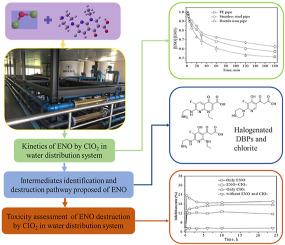Chemosphere ( IF 8.1 ) Pub Date : 2021-06-18 , DOI: 10.1016/j.chemosphere.2021.131251 Guilin He 1 , Tuqiao Zhang 2 , Qingzhou Zhang 3 , Feilong Dong 4 , Yonglei Wang 5

|
Enoxacin (ENO) is widespread in water because it is commonly used as a human and veterinary antibiotic. However, little effort has been dedicated to revealing the transformation mechanisms of ENO destruction using ClO2, especially within a water distribution system (WDS). To address this knowledge gap, the kinetics, byproducts, toxicity, and formation potential of halogenated disinfection byproducts (DBPs) associated with ENO destruction using ClO2 in a pilot-scale PE pipe was explored for the first time. Statistical analyses showed that the destruction efficiency of ENO in the pilot-scale PE pipe was lower than that in deionized water (DI water), and the reactions in DI water followed the second-order kinetic model. Furthermore, pH has a significant effect on the destruction of ENO, and the removal ratio increased at a higher pH. Additionally, increasing the flow rate elevated the ENO removal efficiency; however, the influence of flow velocity was limited to ENO destruction. The ENO removal rates within the diverse pipes exhibited the following order: stainless steel pipe < PE pipe < ductile iron pipe. Nine possible intermediates were identified, and those that were formed by piperazine group cleavage represented the major primary byproducts of the entire destruction process. Additionally, the ENO destruction in a pilot-scale PE pipe had minimal influence on halogenated DBPs and chlorite formation. Finally, the toxicity evaluation illustrated that the presence of ENO increased the potential risk of water quality safety when treated with ClO2.
中文翻译:

配水系统 ClO2 消毒过程中依诺沙星 (ENO) 的表征:动力学、副产物、毒性评估和卤化消毒副产物 (DBP) 形成潜力
依诺沙星 (ENO) 广泛存在于水中,因为它通常用作人类和兽用抗生素。然而,很少有人致力于揭示使用 ClO 2破坏 ENO 的转化机制,尤其是在配水系统 (WDS) 中。为了解决这一知识差距,与使用 ClO 2破坏 ENO 相关的卤化消毒副产物 (DBP) 的动力学、副产物、毒性和形成潜力首次探索了中试规模的 PE 管道。统计分析表明,中试PE管中ENO的破坏效率低于去离子水(去离子水),在去离子水中的反应遵循二级动力学模型。此外,pH 值对 ENO 的破坏有显着影响,在较高的 pH 值下去除率增加。此外,增加流速可提高 ENO 去除效率;然而,流速的影响仅限于 ENO 破坏。不同管道内的 ENO 去除率呈现以下顺序:不锈钢管 < PE 管 < 球墨铸铁管。确定了九种可能的中间体,那些通过哌嗪基团裂解形成的中间体代表了整个破坏过程的主要主要副产物。此外,中试规模 PE 管道中的 ENO 破坏对卤化 DBP 和亚氯酸盐形成的影响最小。最后,毒性评估表明 ENO 的存在增加了使用 ClO 处理时水质安全的潜在风险2 .









































 京公网安备 11010802027423号
京公网安备 11010802027423号